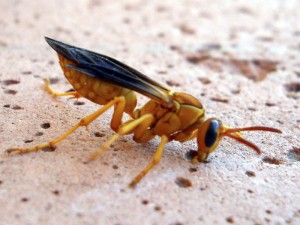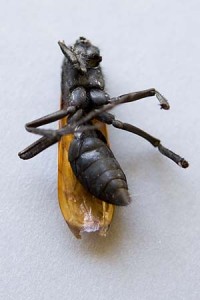Stinging pests commonly found in the Verde Valley and Prescott Valley.
Paper Wasp

The Paper Wasp that we find most commonly around our homes. These guys will sting if provoked but seem to be more at ease than its cousin the yellow jacket. They start to build their nests in the springtime and their colony consists of one dominant female and several worker females. The adults feed on nectar and the larva feed on insects that the adults chew up for them. My experience with them is they seem pretty tolerant of human activity but will attack if they feel threatened. It is my recommendation to locate and remove wasps early in the season to keep the population from getting too big.

Mud Dauber
The Mud Dauber is a wasp that makes the brown mud tubes on the wall. The nest can resemble organ pipes so they are also called the organ pipe mud dauber. They are a very docile wasp and generally don’t sting unless harassed. If they start to build a nest on your house you can take in down at night since this wasp doesn’t live in it. Their nest is actually a incubation chamber for their young. They will catch a spider and paralyze it, then place it in the chamber with the larva. It will become the larva’s food source while it grows. These wasps are not really a threat but they can build the unsightly nests.
Tarantula Hawk

This Tarantula Hawk wasp is a solitary wasp that travels the earth looking for you guessed it, Tarantulas. They also, like the mud dauber, use the spider for the food source of their larva. Although I have never heard of anybody being stung by one, they are said to have a very painful sting. They are a metallic blueish black with red wings and a elongated rear abdomen. I wouldn’t consider these wasps a threat. There isn’t any control method suggested since they just appear randomly out in the environment.

Cicada Killer
The Cicada Killer wasp is one of the world’s largest wasps. The biggest problem with them isn’t the threat of being stung, but the mess they make in our yards. I have been around these wasps a lot and have never been stung. The main area we find them is in the Village of Oak Creek area of Sedona. Generally between June and July you will find them digging up the yard and hunting the cicada’s. They only seem to last about three to four weeks and then they are gone again until next year. Having your pest control professional treat the mounds they dig will help treat for the future generations.
Yellow Jacket
The Yellow Jacket is not very common in the Verde Valley area. Over the years I have only seen a half a dozen nests. The one thing I will say is they are about as aggressive as the Africanized Honey Bee. They are mean little guys when you get into their nesting area. They like to mess up our picnics by getting into soda cans and getting all over the meat. Traps can be effective if you are picnicking but nest eradication is the best if the nest can be found.
Bald-Faced Hornet
Like the Yellow Jacket, the Bald-Faced Hornet is not very common in the Verde Valley. Have ran into them twice and found then to be very aggressive both times. They have a black body with a white face and they build the nest that you see on TV cartoons that looks like a football. If you come across them on your property call a professional. I have heard of some folks trying to give them the garden hose treatment and this always results in them running as the wasps chase them.
